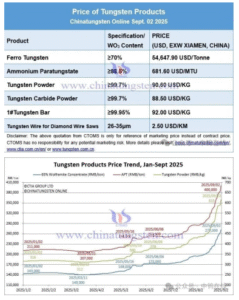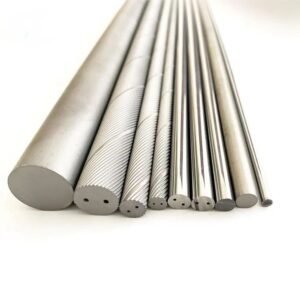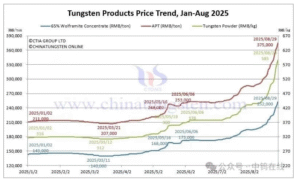When selecting materials for industrial applications, aerospace engineering, or machining tools, tungsten and titanium are often considered for their exceptional strength and durability. Both metals offer unique advantages, but the question remains: Is tungsten stronger than titanium? The answer depends on how “strength” is defined. Strength can refer to hardness, tensile strength, toughness, or resistance to heat and corrosion—all of which impact their suitability for different applications.
Below, we explore the key differences between tungsten and titanium, comparing their properties, industrial applications, and how they perform under various conditions.
1. Hardness and Wear Resistance
Hardness is a crucial factor in determining a material’s ability to withstand scratches, deformation, and wear. Tungsten is significantly harder than titanium, making it ideal for cutting tools and industrial applications requiring extreme durability.
- Tungsten has a Mohs hardness of 7.5–9.5, making it one of the hardest metals available. Tungsten carbide (WC), a composite of tungsten and carbon, is even harder, reaching Mohs 9, close to diamond.
- Titanium has a Mohs hardness of 6.0, which is relatively soft compared to tungsten. While still strong, titanium is more prone to surface scratches than tungsten.
Because of its superior hardness, tungsten is widely used in cutting tools, industrial dies, and wear-resistant coatings, whereas titanium is preferred for applications that require toughness rather than extreme hardness.
2. Tensile Strength and Structural Durability
Tensile strength measures how much force a material can withstand before breaking. Tungsten has a higher tensile strength than titanium, meaning it can endure more stress before fracturing.
- Tungsten’s tensile strength ranges from 980 MPa to 1,510 MPa, making it one of the strongest pure metals.
- Titanium’s tensile strength varies between 434 MPa and 1,400 MPa, depending on the alloy composition.
While tungsten can withstand higher forces, titanium’s ability to form strong alloys gives it competitive strength while maintaining flexibility, which is critical in aerospace and structural applications.
3. Toughness and Impact Resistance
Although tungsten is stronger in terms of hardness and tensile strength, it is also brittle. When subjected to sudden impact or shock loads, tungsten can crack or shatter.
- Tungsten is brittle, which makes it unsuitable for applications requiring high-impact resistance.
- Titanium is highly ductile and tough, meaning it can withstand impacts and deformation without breaking.
This toughness makes titanium the preferred material for aircraft structures, medical implants, and sports equipment, where flexibility and impact resistance are crucial.
4. Weight and Density
Another major difference between tungsten and titanium is their density. Tungsten is one of the heaviest elements, while titanium is known for its lightweight properties.
- Tungsten density: 19.3 g/cm³ (almost as dense as gold).
- Titanium density: 4.5 g/cm³ (about 1/4 the weight of tungsten).
Because of this weight difference, tungsten is used in applications where high mass is beneficial, such as counterweights, ballast, and radiation shielding. Titanium, on the other hand, is preferred in aerospace, automotive, and sports applications, where reducing weight is essential for performance.
5. Heat Resistance and Corrosion Resistance
Both tungsten and titanium perform well under extreme conditions, but they excel in different ways.
- Tungsten has the highest melting point of any metal: 3,422°C, making it ideal for high-temperature applications such as rocket nozzles, electrical contacts, and furnace components.
- Titanium has a lower melting point of 1,668°C, but it offers exceptional corrosion resistance. It forms a natural oxide layer that protects it from rust, making it highly durable in marine environments, chemical processing, and biomedical implants.
Tungsten is the better choice for extreme heat, while titanium is the better choice for environments exposed to moisture, chemicals, or biological conditions.
6. Industrial Applications of Tungsten vs. Titanium
Because of their distinct properties, tungsten and titanium serve different industrial purposes.
| Property | Tungsten | Titanium |
|---|---|---|
| Hardness | Extremely high, scratch-resistant | Lower, more flexible |
| Tensile Strength | Higher (980–1,510 MPa) | Moderate to high (434–1,400 MPa) |
| Toughness | Brittle, prone to breaking | Tough, impact-resistant |
| Weight | Very heavy (19.3 g/cm³) | Lightweight (4.5 g/cm³) |
| Heat Resistance | Extreme (melting point 3,422°C) | High (melting point 1,668°C) |
| Corrosion Resistance | Moderate | Excellent (oxide protection) |
| Best Applications | Cutting tools, armor, industrial machinery | Aerospace, medical implants, sports equipment |
When to Use Tungsten
- Heavy-duty industrial cutting tools and machining inserts (tungsten carbide).
- High-temperature environments such as furnaces, rocket nozzles, and electrical components.
- Radiation shielding and counterweights due to its high density.
When to Use Titanium
- Aerospace components, where lightweight strength is crucial.
- Medical implants and surgical tools, due to its biocompatibility.
- Corrosion-resistant applications like marine structures and chemical processing.
Conclusion: Which is the Better Choice?
The strength of tungsten vs. titanium depends on the application.
- If hardness, wear resistance, and heat tolerance are priorities, tungsten is superior. It is the best choice for cutting tools, industrial applications, and high-temperature environments.
- If toughness, impact resistance, and lightweight strength are required, titanium is the better option. It is ideal for aerospace, medical, and marine applications where durability and corrosion resistance are essential.
For CNC machining, tungsten carbide cutting tools are preferred for their extreme hardness and longevity, especially when cutting difficult materials like titanium alloys. At Zhuzhou Zhirong Advanced Materials Co., Ltd., we specialize in high-performance tungsten carbide cutting tools, including turning inserts, milling inserts, end mills, and drills, designed to optimize machining efficiency and durability.
If you need expert recommendations on cutting tools for machining titanium or other materials, contact us at crystalyuan@zrzhirong.com or visit www.zhirongcarbide.com. We also offer free samples for testing to help you find the best solutions for your machining needs.





